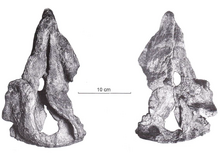Kogia pusilla
| Kogia pusilla Temporal range:
| |
|---|---|

| |
| Top (left) and underside (right) views of the skull | |
| Scientific classification | |
| Domain: | Eukaryota |
| Kingdom: | Animalia |
| Phylum: | Chordata |
| Class: | Mammalia |
| Order: | Artiodactyla |
| Infraorder: | Cetacea |
| Family: | Kogiidae |
| Genus: | Kogia |
| Species: | †K. pusilla
|
| Binomial name | |
| †Kogia pusilla Pilleri, 1987
| |
Kogia pusilla is an
.Taxonomy
| Kogiidae | ||||||||||||||||||||||||||||||
| ||||||||||||||||||||||||||||||
| K. pusilla within Kogiidae[1] |
The
million years ago (mya). Teeth and periotic bones of the inner ear were also found in the area, possibly belonging to K. pusilla.[2][3]
The skull was first donated to the Museo di Paleontologia of the
K. pusilla is the third fossil
kogiid whale described, after Praekogia from 1973 and Scaphokogia from 1988, and the third member of the genus Kogia, with the modern day dwarf sperm whale (K. sima) and pygmy sperm whale (K. breviceps).[2] The other two kogiids are Thalassocetus and Nanokogia.[1]
The dwarf and pygmy sperm whales are more
Early Pliocene 5.3 mya.[1]
Description

K. pusilla is differentiated from the dwarf and pygmy sperm whales by its more elongated snout, smaller
Physeteridae in contrast to the triangular lacrimal bone of Kogiidae. Like other kogiids, it does not have nasal bones.[2] Thinking it was a beaked whale and using the holotype of Placoziphius for scale, Capellini estimated the length at 1.25 meters (4.1 ft).[4]
Paleoecology
K. pusilla, like the other Kogia, had a blunt snout, likely an adaptation for
niche, squid were probably more abundant in the Mediterranean during the Pliocene than present-day.[1][2]
Paleobiology
Neptune grass
(Posidonia oceanica)The Rocca locality in Volterra is representative of a
References
- ^ PMID 25923213.
- ^ ISSN 2039-4942.
- ISSN 0035-6883.
- ^ a b Capellini, G. (1893). "Nuovi resti di Zifioidi in Calabria e in Toscana" [New Ziphoidea remains in Calabria and Tuscany] (PDF). Rendiconti (in Italian). 2: 283–288.
- OCLC 19115575.
- ^ Bianucci, G. (1997). "The Odontoceti (Mammalia: Cetacea) from Italian Pliocene. The Ziphiidae". Palaeontographia Italica. 84: 1–7.
- ^ Cioppi, E. (2014). "I cetacei fossili a Firenze, una storia lunga più di 250 anni" [The fossil cetaceans of Florence, a history of more than 250 years] (PDF). Museologia Scientifica Memorie (in Italian): 81–89.
- ^ "Volterra (Pliocene of Italy)". Fossilworks. Gateway to the Paleobiology Database. Retrieved 13 August 2018.
- ISSN 0753-3969.
